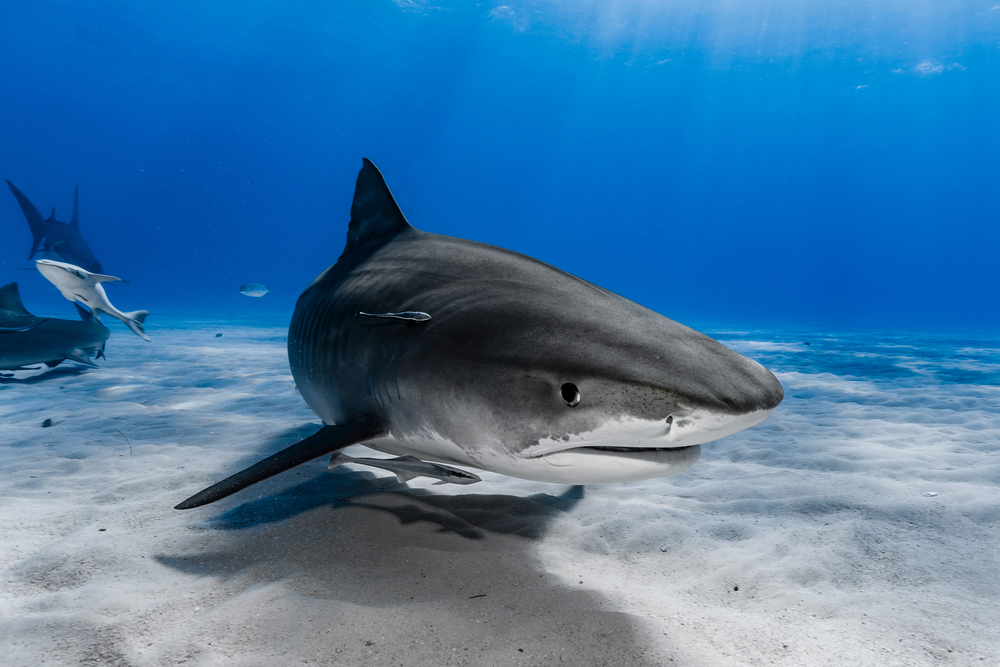Wolves are often considered dangerous, but other, smaller animals and insects have actually killed more humans.
Millions of people are killed by animals every year, and while wolves did make it on this list, you might be surprised to learn which other animals are the deadliest.
Table of Contents
The 15 Deadliest Animals
| Number | Animal | Deaths per year |
|---|---|---|
| 1 | Mosquitoes | 750,000 |
| 2 | Humans | 437,000 |
| 3 | Snakes | 100,000 |
| 4 | Dogs | 35,000 |
| 5 | Snails | 20,000 |
| 6 | Assasin bugs | 12,000 |
| 7 | Tsetse flies | 10,000 |
| 8 | Ascaris roundworms | 4,500 |
| 9 | Crocodiles | 1,000 |
| 10 | Tapeworms | 700 |
| 11 | Hippotamuses | 500 |
| 12 | Elephants | 500 |
| 13 | Lions | 22 |
| 14 | Wolves | 10 |
| 15 | Sharks | 6 |
1. Mosquitoes: 750,000

Mosquitoes are considered the deadliest animal to humans. Over the past few years, death by mosquito bites has increased around the world. It is estimated that more than 850 thousand people die as a result of their mosquito bites.
This is because when a mosquito bites you, it can transmit deadly diseases and parasites. If you’ve visited Africa or areas of Asia, you know that many countries struggle with controlling diseases – such as malaria or Dengue fever – transmitted by mosquitoes to humans.
With direct involvement from public authorities and the development of new treatments, however, the future number of mosquito-related deaths can decrease.
2. Humans: 437,000

Maybe it’s no surprise to you given what we see in the media these days, but humans are the second deadliest animal in the world – and this is just taking into account homicides. It is estimated that around 437 thousand humans die each year at the hands of other humans.
These numbers tend to be concentrated in areas high in poverty and low in socio-economic opportunity and are directly affected by access to drugs, alcohol, and guns.
3. Snakes: 100,000

Did you know that snakes kill more than 100 thousand people each year? Of these snakes, cobras and vipers are the most dangerous. Unfortunately, most lethal snake attacks happen in Africa and India, countries already struggling with HIV and malaria, and in areas where healthcare services are difficult to access.
And unfortunately, even the data regarding snakebite survivors is grim.
While surviving a venomous snakebite seems like a positive thing, many of those who survive cobra bites are at the risk of developing serious conditions and losing legs or fingers.
When the victims survive, it is often at great cost to their overall physical condition. This is quite unlike those who survive mosquito-related illnesses, where the effects of the bites will diminish over time.
4. Dogs: 35,000

You might not want to believe that man’s best friend landed such a high rank on this list, but dogs are responsible for more than 35 thousand human deaths each year.
There are a few reasons why a dog bite victim can die. In some cases, the bite perforates veins and causes them to bleed out.
However, in most cases, those who die from dog bites do so because they are infected with rabies, a dangerous virus that affects brain tissue and ultimately causes death.
If you are bitten by a dog, make sure you rush to the hospital to get an anti-rabies shot – it just might save your life.
5. Snails: 20,000

That’s right, snails. Like other animals on this list, snails can transmit a parasite that is deadly to humans. Snails found in tropical and subtropical waters transmit schistosomiasis, a parasite that causes infertility, bladder cancer, rashes, stomach problems, and in some cases, death.
Unlike some other parasites, however, schistosomiasis is fairly easy to treat using an anti-parasitic that is administered in one or two doses a few weeks after the initial infection, so you don’t have to worry too much about dying on your next trip to the tropics…from snails, at least.
6. Assassin bugs: 12,000

Also known as kissing bugs, the Reduviidae species is responsible for more than 12,000 deaths per year. These deaths are recorded mostly in Central and South America, where these bugs typically bite their victims on soft tissue such as eyes or lips.
In the first few weeks, victims show mild symptoms such as headaches or stomach aches, but past the 6-week mark, assassin bug infections turn serious.
For those with previous health conditions, these bugs can lead to heart failure, but there are currently various medications being tested to treat the disease.
Vaccines for the parasites the disease comes with are also under development. The most common parasite transmitted through an assassin bug is Trypanosoma cruzi, and vaccines against these parasites will hopefully be released in the next few years.
7. Tsetse fly: 10,000

Tsetse flies live in the tropical regions of the world and are responsible for more than 10,000 deaths each year. These flies are also called the “sleep of death flies”, as their bites put their victims in a deep sleep that many never wake up from.
Even before falling asleep after a bite from a tsetse fly, victims start to experience severe headaches and severe muscle pain. If you are bitten, you need medication as soon as possible to treat the infection.
However, the window for treatment is small, as the infection spreads quickly and renders medication lethal if it has already reached the brain.
8. Ascaris roundworm: 4,500

Ascaris is a type of worm that grows in human feces and is very dangerous once it gets into the intestinal system.
The World Health Organization reports more than 60,000 kids die each year from infection due to this worm.
Simple health measures such as washing your hands before eating and avoiding contact with soil that has been in contact with feces can save your life.
Kids are prone to these problems, and surprisingly, deaths occur even in the developed world. Having a good hygiene routine from early childhood can keep Ascaris away from children and adults.
9. Crocodiles: 1,000

As nature documentaries often depict, crocodiles are fearsome hunters. Lurking below the waters before leaping out to snatch their prey, crocodiles aren’t known for being too picky regarding their next meal.
Distinguished from alligators by their size, teeth, and habitats, crocodiles are responsible for killing an estimated 1,000 people each year.
Many of these deaths, however, happen in remote areas with poor access to health care. Due to these remote locations, it is also possible that the number of deaths is in fact higher than recorded.
10. Tapeworms: 700

Another (and last) parasite on this list of deadliest animals is the tapeworm. While humans can live in symbiosis with tapeworms, having one in your body can also be deadly.
Humans get tapeworms by ingesting food or water containing tapeworm larvae, and if those larvae travel outside of your intestines, you’re in for a world of hurt.
Tapeworms can travel to the heart, lungs, or brain and cause fatal seizures for those they have infected. However, tapeworms can be effectively treated with medication if diagnosed quickly enough. Good handwashing techniques, clean water, and thoroughly cooking your food (especially pork) are all ways you can prevent ingesting tapeworm larvae.
11. Hippopotamuses: 500 (tie)

Don’t be deceived by a hippo’s cute and goofy appearance – these aggressive African mammals kill an estimated 500 people each year.
Known for being extremely territorial and aggressive, hippos have been reported to tip over boats, drag humans into rivers, trample, and bite humans when they are feeling threatened.
Habitat loss and poaching put pressure on hippos, meaning that these massive animals and humans cross paths more often than either creature would like. If you take a trip to Africa, be wary of the unassuming, deadly hippo.
11. Elephants: 500 (tie)

Tied with hippos for eleventh place, elephants are another large African mammal known for killing its fair share of humans. It is estimated that each year, elephants are responsible for approximately 500 human deaths, a number that could rise if their habitats continue to be threatened.
Elephants are social and intelligent creatures and will attack humans if they feel spooked or like their space is being invaded. Humans who are killed by elephants are either trampled or gored to death (have you seen those tusks?), not a great way to go.
Male elephants who are looking for a mate are also more likely to charge a human, as their testosterone levels are higher at this time and make them more aggressive.
13. Lions: 22

You might have been wondering if lions would be on this list, and despite only killing 22 people a year, they are still one of the deadliest animals to humans.
Like many previously mentioned animals, lions typically only attack humans if they perceive them as an irritant or threat. That being said, some lions that are sick, old, or starving will attack humans with the intention of making them a meal.
In fact, some lions have earned the title of “man-eaters”, as they seem to seek out humans for food even when they are not starving or sick and have other resources for food available.
14. Wolves: 10

Despite being the fearsome villain in many a fairytale or legend, wolves only kill about 10 humans a year. Still, that’s enough to get them on this list of deadliest animals.
Wolves are pack hunters, and if they are provoked by the loss of habitat and starvation, they will attack humans for food. This is quite rare, however, and wildlife specialists assure people that being killed by a pack of wolves is quite unlikely.
Like dogs, however, a wolf is incredibly dangerous if it is infected with rabies. Also, a wolf that feels cornered or needs to protect its cubs will certainly attack a human, so it is a good idea to always give these creatures their space.
15. Sharks: 6

Last but not least on this list of deadliest animals is the shark. Many people might be surprised to learn that sharks only kill about 6 people per year, despite their fearsome reputation.
Contrary to what many films will have us believe, sharks do not seek out human flesh. Shark attacks occur because the shark is curious, confused, or in some rare cases, territorial or provoked.
When a shark attacks a human out of curiosity or confusion, it is trying to determine if the human is something that it would like to it. After biting, sharks quickly realize that the person is not their usual food and let go and swim away.
Unfortunately, even these curious bites can be detrimental to a human.
Sharp teeth and large jaws can easily tear away limbs and large amounts of flesh, meaning the victim bleeds out before help can arrive. In some cases, sharks will drag humans under the water for quite some time before letting go, causing the person to drown.
















